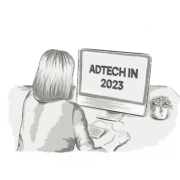2021 was another big year for the AdTech, MarTech and programmatic advertising industries. We saw Apple roll out more privacy changes, progress made (and lost) with Google Chrome’s privacy sandbox, and numerous mergers and acquisitions.
But what does 2022 have in store?
We asked a few industry insiders about what they thought the main trends, challenges, and opportunities will be this year.
The Main Trends and Challenges in AdTech, MarTech and Programmatic Advertising in 2022
Video Streaming, Augmented Reality (AR) and Podcasts
As AdTech rapidly matures, a variety of companies and new channels have sprung up as a result. Some, like the metaverse which remains an enigma, are more vague than others. I see video streaming, augmented reality (AR) and podcasts as the main trends that every marketer will use at least once in the coming years.
Video-streaming revenue is set to reach $94 billion by 2025. The format and relative placements draw the attention of marketers. Real-time communication sessions, live-stream announcements, setting up online events are major points customers tend to appreciate.
In addition, by 2023 the AR market is estimated to be worth $18 billion. Apart from an improved shopping experience, augmented reality gives consumers a real feel for the things on offer, for instance providing them with a virtual tour. AR can also help consumers make decisions faster, saving expenses on logistics for business owners.
And the last thing I’d like to emphasize is that podcasts, consumed by almost a half of Millenials and over 40% of Gen Zers, grew fast enough for advertising and monetization opportunities.
Dmitriy Atamaniuk, CEO at GDM (Global Digital Marketing Group).
Deep Analysis and More Cord-Cutting
To be honest, there is nothing newer than deeper analysis, which absolutely depends on technology and human efforts. Understanding who your customers are and where they come from is an everlasting challenge, so there is a constant need for analytics and attribution tools that can help marketers divide an audience pool into separate segments easily and develop a personal approach to each group.
What’s more, behind successful communication and marketing results always stands entertainment which is easy to bring to social media, OTT/CTV, audio, AR/VR, and gaming. The great migration of cord-cutters is on the rise, and according to industry predictions, 60 million US households will have shifted from cable and satellite TV to streaming services by 2024.
The COVID-19 lockdowns call for refocusing of ad dollars towards the platforms and services that help get the most out of the industry. My advice for entrepreneurs of any niche would be to conduct a profound analysis of the leaders in the industry. Don’t be afraid of imaginative leaps — they can sometimes save you.
Nikita Platotnenko, CEO at VlogBox.
AdTech, MarTech and Programmatic Advertising Predictions for 2022
Web Advertising
There were a lot of surprises in 2021 around Google Chrome’s Privacy Sandbox, do you think 2022 will be the year where Privacy Sandbox enters the home straight or will there be more changes on the horizon that could potentially delay its introduction in 2023?
RTB House associates are active participants in all of the major communities, such as the W3C, and yet we still find it difficult to predict new outcomes from the ongoing investigations being conducted by CMA, ICO, and DG COMP.
Indeed, the regulatory’s recommendations, opinions and agreements with Google will have a huge effect on the implementation and timeline of the deprecation of 3rd-party cookies on Chrome.
I am positive that the test phase will commence in 2022 and all industry stakeholders will gain access to some significant insights. The question is: How many of these entities will openly share results from the testing phase? And how well are companies prepared for new browser-side marketing APIs? Results from the Chrome origin trials may impact the deadline by introducing the need to improve particular proposals within the Privacy Sandbox.
Finally, on June 21, Google announced its “Opt Out of Ads Personalization” which is effectively its “light” version of Apple’s “ATT”. And following Google’s post back in January 2020, this announcement will no doubt be a precursor to the inevitable, which is a future without AAID (Android Advertising ID) that will probably develop further in the year ahead.
In 2022, we might expect Google to publish a Privacy Sandbox proposal for an in-app environment. Already, current parts of the Attribution Reporting API are showing that Chrome has begun developing the use case of interoperability between in-app and web.
Łukasz Włodarczyk, VP of Programmatic Ecosystem Growth & Innovation at RTB House.
In-App Mobile Advertising
2021 was the year when Apple rolled out its privacy changes to its IDFA. What has been the impact so far and what other privacy changes can we expect to see in the in-app mobile advertising industry in 2022?
When Apple first announced it would be making privacy changes to its IDFA back in June 2020, many people in the industry knew that the revenue impact on app developers would be severe due to the low opt-in rates that would follow as a result of the changes.
Now that these changes have been live since April 26, 2021, we’ve already started to witness the impact.
It’s been reported that Facebook, YouTube, Twitter, and Snap collectively lost 12% of their advertising revenues in Q3 and Q4 of 2021 as a result of Apple’s IDFA changes. That accounts for an eye-watering $10 billion loss in revenue.
But it’s not only the large players that have felt the negative impacts of Apple’s IDFA changes.
App developers have seen the cost of acquiring new users rise and AdTech companies have seen CPMs on iOS inventory drop as a result.
On the flip side, the nature of supply and demand has seen CPMs on Android increase, meaning AdTech companies may have recovered some of those losses experienced on iOS inventory.
In terms of what’s ahead in 2022, Google has already rolled out its own privacy changes to its Advertising ID (aka Google Advertising ID and Android Advertising ID). In late 2021, Google started removing its Advertising ID if a user has opted out of personalized advertising. Prior to this change, the Advertising ID could still be passed to AdTech companies and mobile measurement platforms even if the user had opted out of personalized advertising.
This is a much lighter approach than the one Apple adopted with its IDFA — i.e. instead of asking users to opt in to providing their Advertising ID, Google will simply zero it out if the user has opted out of personalized advertising, which the user will need to do themselves in their phone’s settings.
But many users have opted out of personalized advertising?
According to AdTech company Singular, only around 2% of Android users globally have opted out of personalized advertising. It’s highly unlikely that this number will increase significantly under Google’s current Advertising ID policy, so we can expect the impact to be rather minor.
Michael Sweeney, Head of Marketing at Clearcode.
CTV & OTT Advertising
There’s a lot of improvements being made in CTV and OTT advertising, e.g. around programmatic deals, measurement, and ad fraud. Where do you think most of the progress will be made in 2022?
According to eMarketer, US CTV ad spend in 2022 will grow by 32.3% and reach $19.10 billion. Yet, CTV measurement remains the biggest challenge for a majority of marketers.
The main problem here for many lies in the realization that CTV comes from two worlds: traditional TV and AdTech. While the actual viewing experience resembles linear, CTV’s infrastructure comes mainly from digital and therefore results have to be measured accordingly.
Many CTV players, including TheViewPoint, have been working on educational initiatives to make sure everyone in the industry is on the same page. This has already made a huge difference and will continue to do so in 2022.
Data will definitely remain king in 2022. The rivalry among CTV operating systems, the entry of social media companies in the CTV space as well as numerous acquisitions are supporting this. Data is where I believe we’ll see the most progress and the most fierce competition.
In terms of targeting, which is fueled by data, I think in 2022 we will pay even more attention to its sustainability. New AI-driven algorithms, including automatic content recognition (ACR), are able to analyze how people interact with content, what genres they prefer, and how all this correlates with ads. Therefore, in 2022 we will definitely see more advanced personalized ads empowered by contextual targeting and deterministic data.
eMarketer says that 7 out of 10 CTV transactions in the US are executed programmatically. And this number will only grow. Although direct deals are still popular, particularly among premium publishers, CTV programmatic guaranteed (PG) and private marketplace (PMP) deals have been gaining momentum in the US. This is mainly due to programmatic auctions driving incremental audience reach for advertisers through pinpoint targeting and real-time reporting, which is only likely to improve in 2022.
Finally, I’m convinced we’ll find new ways of protecting brand safety and combat numerous CTV fraud schemes. We have been advocating for SPO and DPO practices in 2021. With the release of more unified tools like IAB’s ads.cert 2.0 protocol, the CTV industry will have more means of building transparent supply chains.
Daniel Elad, Chief Strategy Officer at TheViewPoint.
DOOH Advertising
Digital out-of-home (DOOH) advertising was on an upward trajectory when COVID19 first hit in the first half of 2020. Despite being the hardest-hit advertising channel, it has bounced back. Do you believe the momentum in DOOH advertising will continue where it left off before COVID19 or are there other challenges that could hinder its growth?
It has been an interesting couple of years for digital out-of-home (DOOH).
The start of 2020 saw programmatic outdoor set to evolve planning and execution processes for buyers, as they began to leverage the added flexibility, control and autonomy offered by real-time buying at scale, and developed smarter tactical executions to increase on-target reach and eliminate wastage.
This growth trajectory has been somewhat impeded by COVID-19, however even as the situation continues to evolve and case numbers increase, there are definite signs of green shoots, with the second half of 2021 seeing record numbers of advertisers trialling programmatic campaigns, and record numbers of programmatic DOOH (pDOOH) impressions delivered.
Despite the challenges of the pandemic, programmatic outdoor in the Australian market has been developing well over its formative years, and is now marching into the mainstream of campaign delivery in 2022, with broad adoption from both supply and demand side.
In the current environment of disrupted and unpredictable people-movement patterns, the additional features offered by real-time bidding — e.g. custom scheduling, pacing and targeting, as well as mobile data activation, dynamic triggers incl. weather targeting and frictionless dayparting to name a few — can provide a significant advantage over “traditional” tenancy bookings in empowering marketers to remain agile in pursuing advertiser outcomes.
Agencies and trading desks are adapting and evolving quickly – developing playbooks to determine which clients, campaigns, use cases and market conditions best align with programmatic, traditional or hybrid OOH execution models. Now that programmatic outdoor has reached a strong baseline level of adoption, with supply across almost all Australian media owners, availability via almost all of the major omnichannel DSPs, and trading by all major agency groups, pDOOH is primed to be an execution method of choice for marketers in 2022.
In particular, we’re seeing a proliferation of new advertisers — both digital pure-plays and brick-and-mortar brands — who are accessing digital budgets to trial pDOOH now that many of the targeting techniques used online are available across out-of-home inventory in their DSP.
However, it’s not clear sailing from here on in — there are many challenges from regulatory (e.g. increased privacy regulations limiting device ID availability) to technological (universal support for verification & HTML creatives, upgrades to legacy CMS platforms etc, and more robust post-exposure analytics) that will need to be addressed as pDOOH matures to ensure it can continue to deliver +1s for brands.
The future is bright for programmatic outdoor.
Braden Clarke, Programmatic Director at Val Morgan Outdoor (VMO).
Digital Audio
CTV and OTT advertising has received the lion’s share attention in the programmatic industry recently, but a lot of positive news has been coming out of the digital audio area — podcasts are increasing in popularity, Spotify recently reported a record quarter for ad revenue, and the average time spent listening to digital audio is on the rise. As we head into 2022, what are the biggest opportunities for brands and agencies wanting to invest in digital audio advertising?
Firstly, it’s important for us to apply the appropriate lens to what we’re talking about. Depending on what side of the fence of the digital advertising ecosystem you sit in, the views will deviate about the similarities and disparities between online video and audio.
We see many leaning right into the video opportunity and leaning out on the audio side. It can be difficult to comprehend the difference in this approach. At the end of the day, the only fundamental difference between the two is the visual component.
Brands and advertisers alike have matured their programmatic buying capabilities. For many, audio can become another tool in their media plan to help connect messaging with audiences.
As we look forward to 2022, the biggest opportunities for brands and agencies are:
- Audio is another string to the bow: Buyers and agencies have been trading programmatically for several years and their tech stacks and buying setups have matured. Therefore, adding audio is not a matter of how — it’s the why.
- Define the role of audio: Many are still struggling with how to incorporate audio into a narrative, podcasting and streaming to align with different behaviours and predominantly reflect ‘personal’ listening.
- Subscription isn’t the way to go: With lots of talk and advances towards subscription podcast services in 2021, we’ve yet to see an incredible amount of success. We’ll see a shift back to ad-funded free content which will help push further growth in podcast consumption.
- Addressability: Whilst all audio is not equal when it comes to addressability, many publishers are enabling this across audio streaming on owned assets. Like video, there is an ever-growing opportunity to target specific audiences
If past history is anything to go by, then 2022 will have a lot in store for us. Brands and agencies will have no shortage of work to do in this space and I’m sure we’ll see new niche skill sets emerge to capitalize on the opportunities.
Tim Armstrong, Head of Digital Platforms, Capability and Audience at NOVA Entertainment.
IAB Tech Lab
1. What are the IAB Tech Lab’s main goals and focuses for 2022?
There are three key areas of focus for the Tech Lab next year:
- Continued investment in identity, privacy, and data protection initiatives.
- Supporting the growth of CTV as a channel through new and revised technical standards, including measurement SDKs and improved guidance.
- Evolving frameworks and investing in research that helps to combat fraud, ensures brand safety and improves transparency in ad transactions via Transparency Center
2. What new things (e.g. standards) can we expect to see come out of the IAB Tech Lab in 2022?
Identity remains a key focus and priority for us next year. With this you can expect to see more developments from our Project Rearc and identity work streams where we continue to develop standards that protect consumer privacy online, and where we work with the industry to redefine addressability.
Additionally, given the volume of opportunity for our members within the space of CTV, in 2022 the IAB Tech Lab will continue to support the growth of this channel by expanding the portfolio of technical standards for CTV. This includes the launch of new initiatives such as the Open Measurement SDK for CTV, as well as revisiting existing standards, such as OpenRTB, to deliver updates that will better support the transition of billions of dollars of global ad spend from linear television to CTV.
Lastly, you can expect to see us doing more work in driving awareness and adoption of our existing standards through proof of concepts, research, and increased guidance through our Programmatic Guides and more.
3. How is the IAB Tech Lab helping support AdTech companies, publishers, and advertisers navigate the ever-changing privacy landscape?
Since 2020, through our Project Rearc working group, we’ve brought together stakeholders from across the industry to work together to understand the use cases of identifiers within different companies and to evaluate the impact that comes from their removal.
Through this group we have gone a long way in educating the industry in what the future of addressability looks like, and earlier in 2021 we launched a portfolio of solutions that support varying levels of addressability — from ‘Seller Defined Audiences’, which supports environments where there are no identifiers, to our work to open source and standardize UID 2.0, which is an identifier framework developed by TheTradeDesk enabling privacy safe 1:1 linking of audiences.
Included in this list is also the Global Privacy platform, which addresses global privacy regulations, ID-sources.json, the SKAdNetwork ID list, Accountability Platform and many more. All of these solutions work to build security, privacy and accountability in the heart of our system designs.
We look forward to continuing to evolve this work and drive adoption of these standards in 2022.
Shailley Singh, Senior VP of Product at the IAB Tech Lab.








